Coverage of Japan invariably touches on a variety of regularly trotted out cliches, but arguably one constant is that of a modern, affluent nation. A country that despite its lost decade(s), still benefits from a relatively low unemployment rate, along with an enviably first-class infrastructure.
It’s an approach that admittedly contains a fair bit of truth, but what it also does is brush over the increasing number of people who aren’t aided by any of the above — a large number of whom haven’t done so for quite some time too. And while it’s not difficult to find poverty in many parts of Tokyo (let alone the country as a whole), around Taito-ku, in an area once known as Sanya, it’s starkly and depressingly obvious.
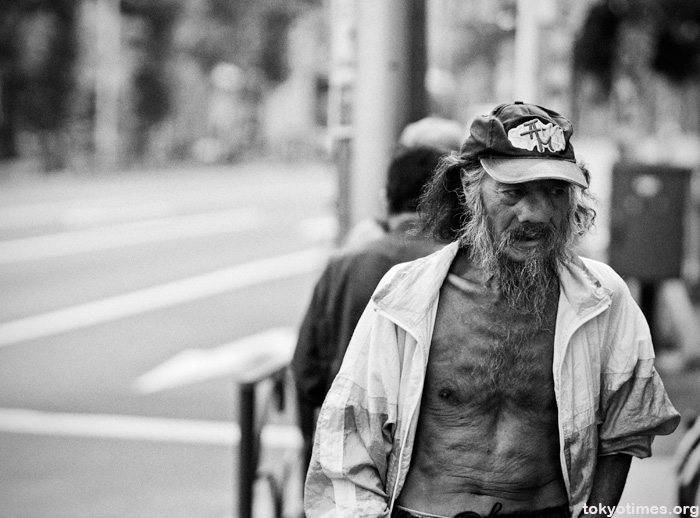
Photographs from this area have appeared on Tokyo Times before — images that are troubling not only in the plight of those featured, but in the potentially voyeuristic element of photographing the dispossessed and homeless in the first place.
It’s an argument that I’ve wrestled with, and one that understandably is often debated on photography sites and forums. But as ethically dubious as such photos can be, with next to no coverage of these problems, both in Japan and elsewhere, it also seems equally questionable not to publish them — even if it is only on a website like this, rather than in a newspaper, or on a site of note.
So here, without further justification or explanation from me, are the rest. All of which were taken in a short space of time, in the space of a few streets.
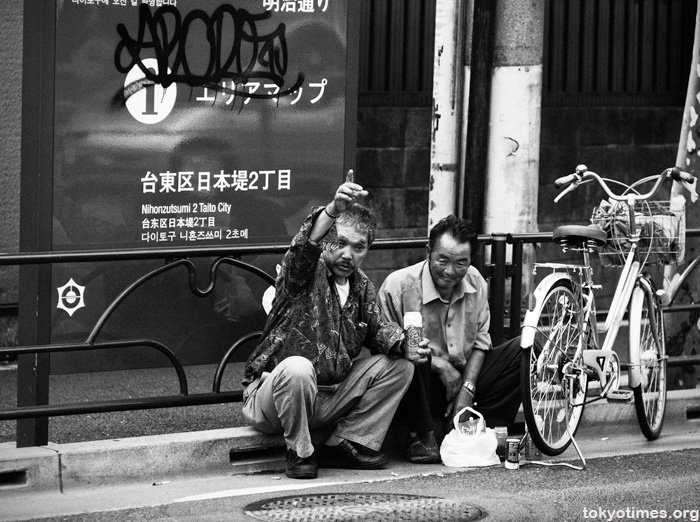
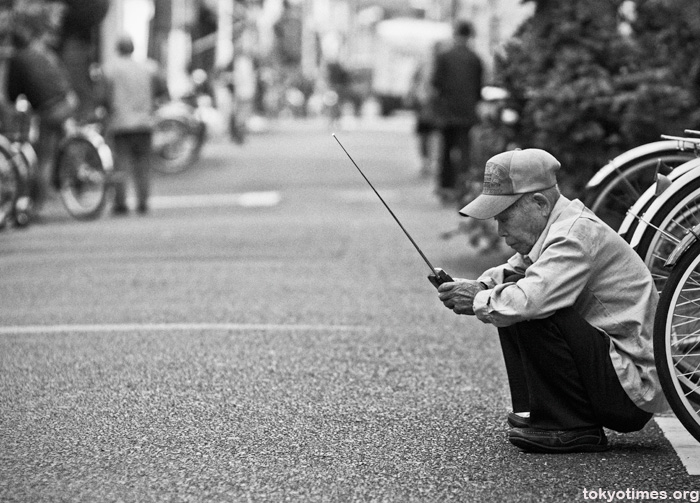
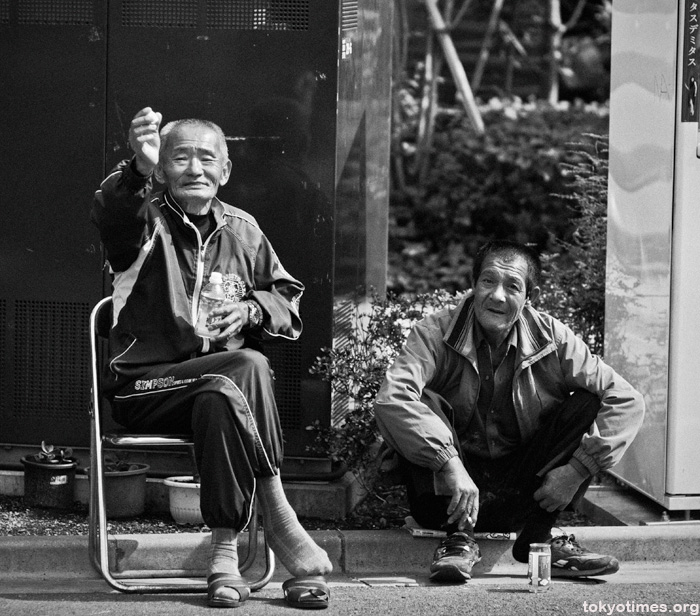
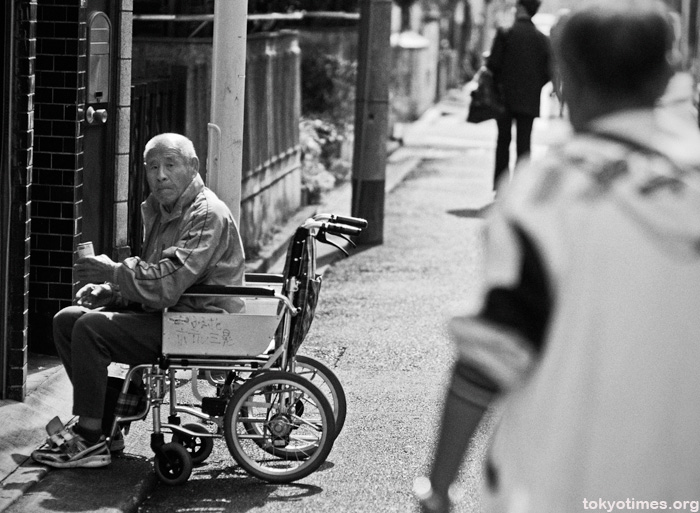
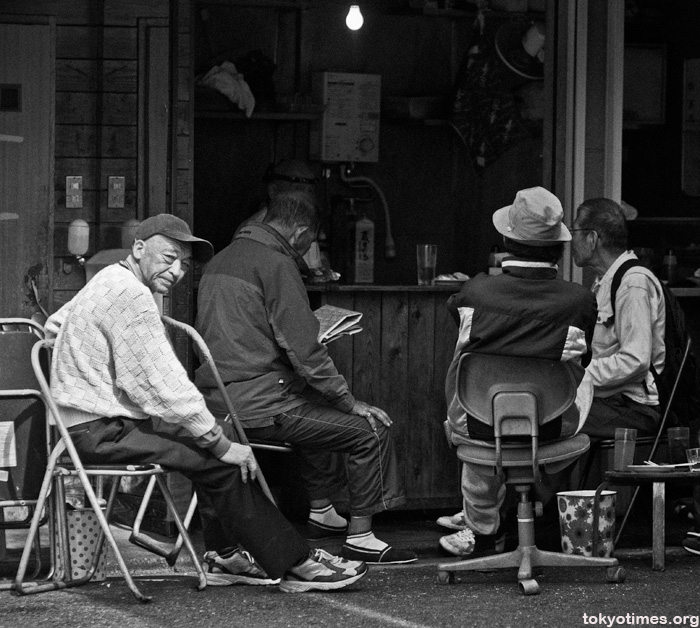
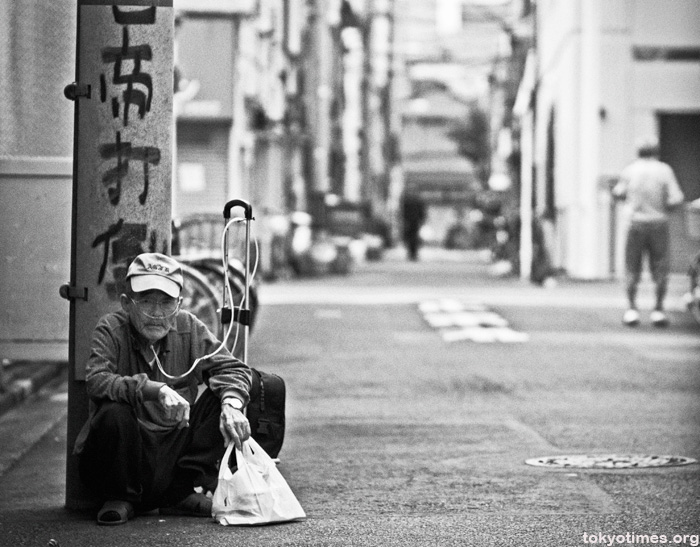
Julie H. says
Good for you! I think it’s important to show all sides of life whether we like it or not.
In a way you are giving a voice to people who may not have one.
It was strange to find out after my first trip to Japan that we had stayed not far from here and the other culturally significant places in that area. Afterwards trying to find information was not easy. But I think it is just as important to document things like this as it is to document shrines and otaku and geisha. I hope you are able to do more here. The history is fascinating.
Lee says
Thanks Julie.
Yes, quite a few cheap tourist/backpacker hotels have sprung up in the area. A combination of the location and relatively cheap land prices I guess. It makes for an odd sight though, seeing the happy tourists amongst the city’s poorest and most downtrodden.
I agree, the area does have an interesting history. A little further towards Asakusa, there are lots of shoe makers, which goes back to the early days. And, I suppose, the area’s connection with society’s outcasts…
Gaijinass says
Awesome.
Taito-Ku. When I worked there I was surprised by the level of poverty. I remember a 7 year old student I had, as I passed by a ddilapitated little house, one I surely thought was condemned, she came squirming out of a broken, rotten plank of a door with her red backpack in tow. She said “Ohayou Gozaimasu”, bowed and then took off jogging to school. She wasn’t the only one either. I remember talking to two teachers at the school and them telling me how the school lunch was so important because so many students there did not get balanced or decent meals regularly at home.
Depressing yet on some level gratifying. Not to see people, particularly children, down on their luck, but rather to feel the bonds and the humanity that rough circumstances inevitably engender within a group or community. I always heard “Hello’s”, “Good Mornings” and “Nice day today’s” while working in Taito Ku. A stark contrast to other more affluent areas I have spent time in around Tokyo.
The school I worked at as well was particularly close, and not in a contrived or awkward way either.
Interesting photos and a great topic.
Lee says
Thanks for the story. Really interesting. I saw a few kids in the area myself. Must be a very odd place to grow up. Good to hear they were looked after though, and I know exactly what you mean about the sense of community and general friendliness. Such a shame that sometimes it takes extreme conditions to engender such behaviour.
Marc Tobolski says
I always have difficulty photographing people – so it must have been difficult to make this decision, especially in a non-exploitative fashion. I have found similar situations in Japan, usually near the primary train stations a mere 4 – 5 blocks away.
Lee says
It wasn’t easy, and to be honest I felt uncomfortable doing it. I was alone too, which made me feel even more self-conscious. Feelings that meant I didn’t hang around for long.
Sadly not hard to find at all, is it? A situation it’s hard to see getting any better. Quite the opposite in fact.
Canuck says
It’s true it a rarely touched upon subject in Japan. Without first inquiring myself, I’ve yet to hear or see anything about poverty in the year and half I’ve been living here.
I do have a comment about the photos you selected to post here though.
The second, third and fifth photo show no little to no visible signs of poverty. I am confused about the content of these photos. Looks to me like some older timers relaxing. The biggest clue in identifying poverty through photographs, the subject’s clothing, seems to be missing here as all the men are adequately attired.
After viewing these photos I would say the country’s image of being “well-off” still stands strong.
Lee says
That’s a good point about their clothes, but the kind of clobber they are wearing can be picked up very cheaply. On the whole, most of the fellas were clean shaven too, despite living a hand-to-mouth existence. Such circumstances don’t mean they can’t have at least some pride, and to me, this is evident in their appearance. Even more so considering their age group.
It really is a wretched place though, and hanging out is pretty much all they can do. A lot of the accommodation in the area appears to be rooming houses, with nightly, as opposed to weekly or monthly fees. So even if they are lucky enough to have a room (and that’s a very relative ‘lucky’ considering the dreadful state many of the places appear to be in), they may not be entitled to spend the whole day there.
Jeffrey says
Canuck,
Without falling into a cliche or being insensitive, the Japanese do poverty better. You’ll see shoes sitting outside the cardboard boxes or blue tarp enclosures that many of the homeless inhabit in various parks. So, even though it is a hovel, some habits die hard.
The most striking of these “encampments” of men (rarely women) that you see outside of places like Sanya (where most of the denizens still have single occupancy rooms and some work), is in the heart of the shopping district in the Sakae area of Nagoya. It’s shocking enough in the underground passage ways of Shinjuku, but try to image seeing this on the high street of any major city in the Western world. That they are allowed to stay in such visible, well-healed areas shows a degree of compassion that some of us don’t necessarily think of as being particularly Japanese sometimes.
Alain alexandre says
I have always asked this question, I must raise my street photo, for the time they remained in my closet. Your photos asks questions about those people living on the street. For these people, the problem is not housing, but first the space they take ownership – one bedroom, one bathroom, non-delivery on the street every morning – while the emergency shelter is still too often the dormitory for the night. Certainly we need more social housing and very social.
Part of the homeless refuse the services offered to help. The problem is so glaring in the winter when in periods of extreme cold, some are kind of their lives at risk. These releases are often the result of people visibly more distressed
They need to develop theories to explain their own terms and try to get out. To decide on their daily activities and their possible strategies in the longer term, finally, like all other social actors. They push them to make reasoned choices – which can sometimes be misunderstood, for example refuse to be hosted in order to preserve his dignity, his integrity only – in their contacts with service support (axiological rationality).
Lee says
Yes, it’s a tough call. I took these photos a while ago, but thought long and hard before posting them.
Jero says
It is important to publish as it can educate and inform. I had constant denial from my gf (Japanese) that there are poor/homeless people in Japan! I think the average Japanese is programmed to see only what they want to see ( we are all middle class) and of course react accordingly. This probably explains why most homeless/poor folks are viewed as failures to be avoided as the programming is……we are all middle class here in Japan and if you really want it, you can get it; a risible notion.
@Canuck have you been anywhere near Shinjuku in your year and a bit? I don’t live in Japan but I see plenty of homesless/poor folks on my visists and that is around Shinjuku!
The thing with Japan is that most visitors are blinded with their particular ‘jones’ to actually see between the cracks!
Lee says
Yes, there does seem to be a denial of the problem, or at the very least a desire to completely ignore it. With a growing number of poor and homeless this will hopefully change, although it’s hard to imagine that happening anytime soon.
Jeffrey says
I read “Sanya Blues” last year. I didn’t know that they had changed the name of the area, but had read, I think, that if not exactly “gentrification” that there was redevelopment occurring the area.
Lee says
Yes, to a certain extent. The most noticeable thing for me was the arrival of cheap tourist hotels. I didn’t really see anything else. Obviously an influx of tourists could well change the place, although at present the area just seems to be where people stay, as opposed to spending any time there apart from at the hotel.
sixmats says
I lived in Asakusa from 2003 to 2005. I did not hear about this part of the history before. Reading about it now helps me understand why there are so many shoe stores around Matsuya the side of town.
Lee says
Yeah, it all sort of makes sense when you find out the area’s history, doesn’t it? Similar disinterest, but a different type of discrimination.
mohjpnmale says
Thanks for the coverage .Can I share this ?
mohjpnmale says
and how many homeless in tokyo?
Lee says
No idea what the number is I’m afraid, but the general consensus is that it’s growing.
And yes, of course you can share it.
James DÃaz says
Respected Lee, Kindest regards and my sincere congratulations for this important contribution to the global society.
I am Colombian but I lived in Tokyo from 1989 to 1998 and know Sanya, was depressing entering this site, where it then came those who had failed in business, in your family life or your work. Retired there for dignity and not feel unsuccessful in their own environment and in front of his family.
I speak Spanish and Japanese, but my English is total chaos.
Courage and again, a thousand and a thousand thanks,
James
Lee says
Thanks a lot, James.
Yeah, it’s a horrible place, but so little known. A truly dreadful way for those men to live out the rest of their lives…
And don’t worry. Your English makes sense and is a thousand times better than my Spanish!
Paul del Rosario says
Nice set of photos, and I applaud your purpose for posting them. I, too, wrestled with this issue (of photogrphing the down and out) when I went thtere a couple of years ago to shoot. I ended photographing the neighborhood instead.
Have you photographed the nearby Yoshiwara area? Very interesting curved road there.
Lee says
Cheers. I went back again and got some more photos. A set I much prefer. You can see them here.
But yeah, it’s a tricky decision. Right in some ways, wrong in others.
I went to the old Yoshiwara area a long time ago, but I need to go back and get some photos. That road sounds very interesting.
mgwrd says
I couldnt understand the relation between shoe shops and Sanya?
Do you happen to have any suggestion of books about the history of this area?
Lee says
Years ago, people who worked with dead animals and their byproducts were social outcasts in Japan. A group afforded none of the status of regular citizens.
Sanya was one of the areas where these people lived and worked, and as such it was home to the leather industry. An element that can still be seen today with all the shoe shops/manufacturers.
Hope that helps. Unfortunately though I can’t help in regards a book. Would like to know of one myself to be honest.